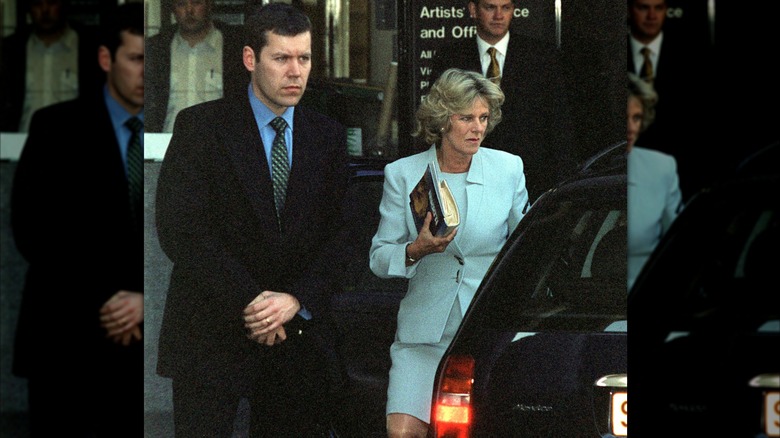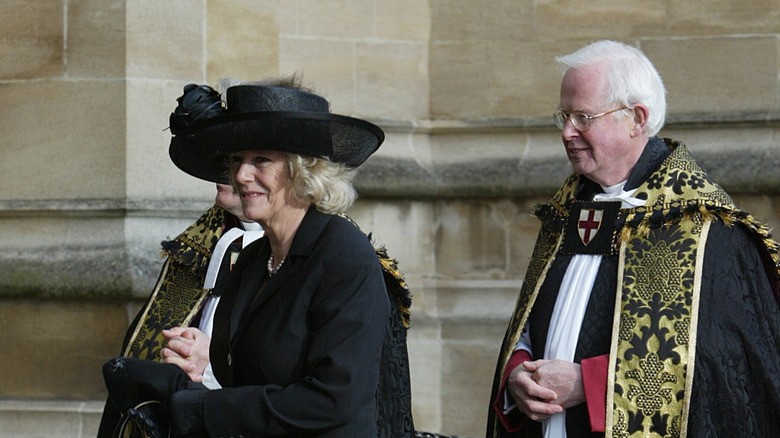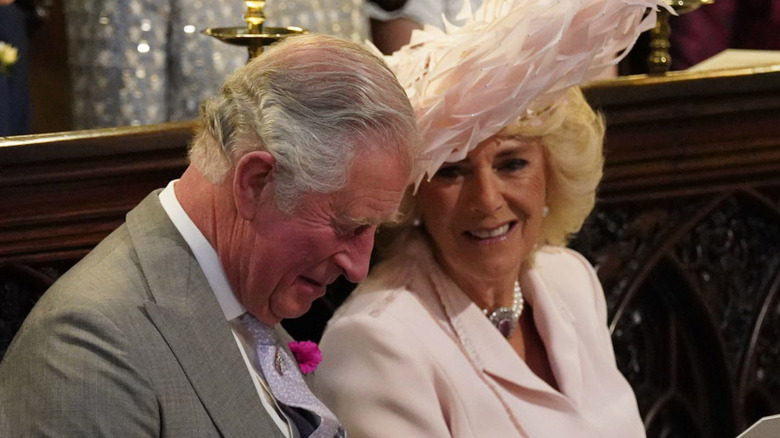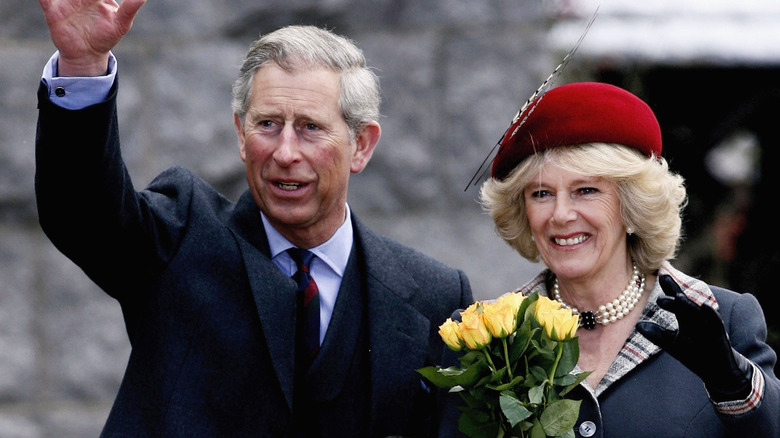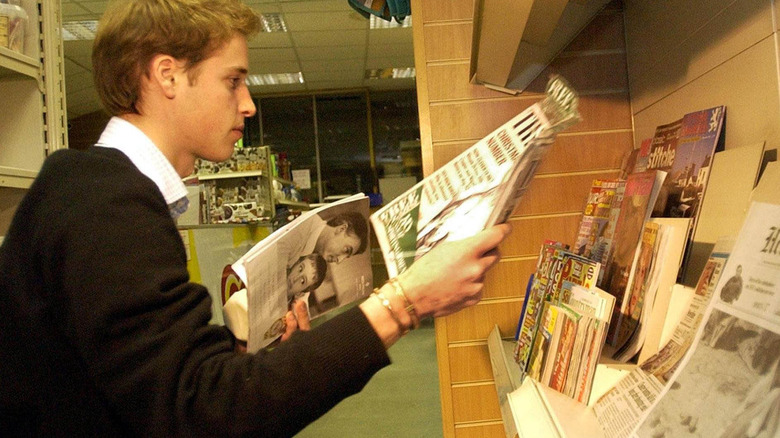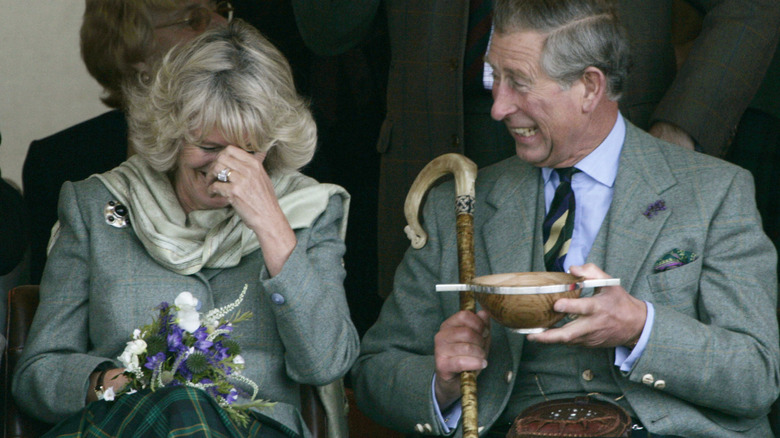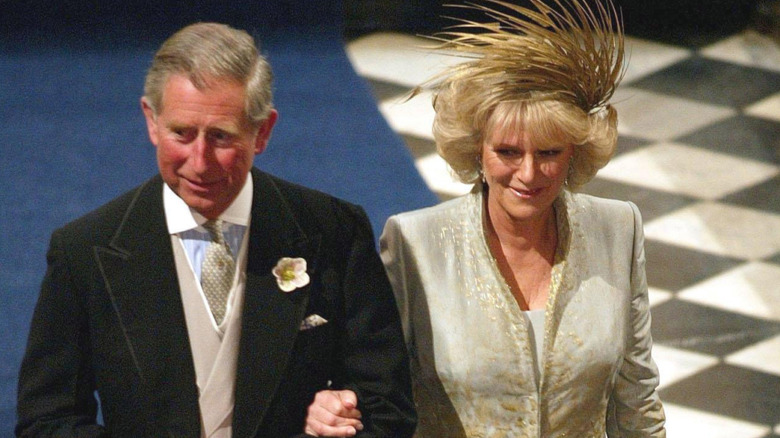Camilla Parker Bowles' Life Was Never The Same After Princess Diana's Death
On August 31, 1997, Princess Diana died in a tragic car accident in Paris. Leading up to the crash, she was one of the most popular women in the world — while her ex-husband's girlfriend, now-Queen Camilla, was one of the most despised. At the time, the public viewed Diana and Camilla as polar opposites. Glamorous, fashionable, and compassionate, Diana had earned the title of the People's Princess. Camilla, meanwhile, was a homier type of personality who liked to hang out with her horses more than dress up — Seriously, just look at the most outdated outfits Queen Camilla has ever worn.
Years later royal expert Tina Brown, admitted, "[S]he was not a glamour girl, Camilla, at any point. I mean, part of her appeal is that this is a woman who likes to wear comfortable shoes that — you know, because she doesn't like to get bunions." Compared to the fashion icon that was Princess Diana, Camilla didn't stand a chance in the court of public opinion. But if that was true before Diana's death, things for Camilla only got worse after that fateful night in August 1997. After Diana died, she faced hatred and judgment from all levels of society. While her relationship with King Charles III evolved for the better, her public image quickly deteriorated — leading to some of the hardest years of her life.
After Princess Diana died, the public despised Camilla Parker Bowles like never before
Queen Camilla was not exactly popular in the months leading up to Princess Diana's death. Known to all as King Charles III's affair partner, Camilla was largely blamed for tearing apart Diana's marriage. But if the public disliked Camilla before Diana died, they absolutely despised her after the princess' fatal car crash in Paris. As royal expert, Ingrid Seward, explained in the documentary, "Queen Camilla: Defiant," "I think Camilla was in a very, very unpleasant situation. She almost became a prisoner in her own home. She was vilified. She was absolutely hated by everyone ... Especially after Diana died. I mean, then she was even more of a prisoner."
In practice, this meant that Camilla received personal attacks from tabloids, acquaintances, and average citizens. Name calling became a part of her daily life. "It's actually almost inconceivable how much abuse Camilla took. I mean, she was called hag, old bag, witch. I mean, these were the kind of words that were used about Camilla for years," royal commentator Tina Brown told The Washington Post. Throughout it all, Camilla did her best to keep her chin up. As the queen would later tell British Vogue, "I was scrutinized for such a long time that you just have to find a way to live with it ... I think in the end, I sort of rise above it and get on with it."
She was snubbed by high society
If dating the Prince of Wales seems like a surefire way to gain acceptance in high society, think again. Following Princess Diana's death, the future Queen Camilla was snubbed in high society like she'd never been snubbed before. When Prince Harry and Prince William's blue-blooded royal nanny, Tiggy Legge-Bourke, got married in 1999, she chose not to invite Camilla to her nuptials. Camilla was also banned from socializing with the Legge-Bourke family on their grand property, the Glanusk Estate. Whenever King Charles III visited them, she had to stay at a nearby village.
All this represented a shocking change for Camilla, who had previously experienced a high degree of acceptance among the upper crust. Prior to her divorce from Andrew Parker Bowles, Camilla had benefited from the social status of the Parker Bowles family and their ties to Queen Elizabeth, The Queen Mother. After Diana died, however, Camilla became such a persona non grata that she could no longer count on her aristocratic connections to keep her social life afloat. According to Ingrid Seward in the documentary, "Queen Camilla: Defiant," the social isolation was so intense that Queen Elizabeth II began to call Camilla a "much-maligned woman." As the royal expert shared, "I mean, actually, the queen felt very sorry for her ... They'd known the Parker Bowleses all their life ... So, the queen felt desperately sad for Camilla."
King Charles III and Queen Camilla had to sit separately at royal events
Just because Queen Camilla was excluded from Tiggy Legge-Bourke's nuptials does not mean that she was never invited to any other important event. Following Diana's death, Camilla was permitted to attend other important ceremonies. This was evident in 2005 when she was asked to join the royal family at the funeral of Sir Angus Ogilvy, who had been the husband of Princess Alexandra of Kent.
But Camilla's presence at the gathering did not mean that all was well in paradise — far from it. Higher-ups at the palace determined that the optics of King Charles III attending an official funeral alongside his former affair partner were less than ideal. Nobody wanted to remind the public of another royal funeral — Diana's — which did not exactly cast Charles and Camilla in the most positive light. Because of this, Queen Elizabeth II told the pair that they would not be allowed to sit side by side at the event. Both Charles and Camilla received this news with a certain degree of humiliation.
Making matters worse, Charles and Camilla were just months away from getting married at the time — a factor that didn't seem to quell the concerns of the queen and her courtiers. One palace official said that Charles was furious with the arrangement, according to The Sun, and described the future king as "incandescent with rage." His anger, though, did little to mitigate the lasting effects of Diana's death.
Experts claimed that Camilla would never become queen
After Princess Diana's death, Queen Camilla was despised by all levels of society. She was admonished by the public, excluded by the elite, and pushed aside by the royal family. Because of this, royal experts were convinced that she would never be allowed to wear the crown. The respected British historian Dr. David Starkey didn't even consider the eventual coronation of Camilla to be a possibility. The Real Royalty documentary "The Full Story of the U.K.'s New Consort" even quoted him as stating, "Camilla, I think, is now permanently the mistress. She is now permanently behind the scenes. She will never become queen. She will never have a coronation."
While these statements may come across as intense, Starkey believed that the tragedy of Diana's death had made it impossible for anyone to fill her shoes. The same documentary went on to explore his theory that, "There will be always a ghost Queen Diana. By a deep paradox, Diana's death put her back into the royal family. And in a funny kind of way, she's queen from beyond the grave." Of course, time has shown otherwise. After her 2023 coronation, Queen Camilla holds a legitimacy that Queen Diana will never obtain. However, part of Starkey's theory rings true. Although Diana left her role as a working royal in 1996, the world remembers her as a princess. To say that Camilla had an easy time facing this memory would be untrue.
Queen Camilla and King Charles III decided to hire a public relations team
Because of all the negative press swirling around Queen Camilla and King Charles III, it was decided that the couple would need to hire a public relations team. Desperate to revolutionize their image, the duo hired Mark Bolland. According to royal expert Valentine Low in his book "Courtiers," Bolland was willing to embrace particularly ruthless tactics to achieve his goal. Low called Bolland "clever, charming, manipulative," if not also "one of the most colorful and interesting players in the royal drama of the last 30 years."
Although Bolland has drawn criticism for the intensity of his strategies, it would be impossible to say that he didn't get results. By encouraging Camilla to support important causes and create friendships within the firm, Bolland helped her become the type of public figure people could admire. In 2023, a royal insider even told The Guardian, "If you look at Camilla now, she's on the Privy Council. She was a firm favorite of the queen. And when she became queen consort, that was the culmination of the job that Bolland started."
As much as Bolland's work has helped Camilla, however, it's important to note that her projects reflect her personality — not some fake public image. As royal expert Tina Brown told NPR, "I mean, she's a passionate reader. She started a book club. ... You know, she also works with animals, and we know she's passionate about riding and dogs.
Queen Camilla's public relations makeover may have come at Prince William's expense
While Mark Bolland was certainly successful at revamping Queen Camilla's image, he also made her a few enemies. The public relations guru has been accused of occasionally making Camilla look good in the press by casting Prince William and Prince Harry in a negative light. As Tina Brown told NPR, "There was a period when Charles, to really rehabilitate both his own image and that of Camilla after the death of Diana, hired a quite resourceful and, shall we say, sophisticated press secretary ... Harry felt strongly that he and William were sometimes thrown under the bus for the sake of their father and for Camilla's PR."
One example of this may have occurred in 2001 when it was reported that William was having a hard time at the University of St. Andrews. As royal expert Robert Lacey explained in his book "Battle of the Brothers," the prince considered transferring schools, but the palace did not let him. Sensing an opportunity to refine Charles and Camilla's public image, Bolland leaked the story to the press. "Prince Charles emerged from the article as the hero of the hour. Far from consenting to William's wish to leave St. Andrews ... the Prince of Wales was presented as a wise and firm father who urged his son to 'stick with it.'" The story, however, came at the expense of William's privacy — and reputation.
Diana's death allowed King Charles III to introduce Camilla Parker Bowles to Prince Harry and Prince William
While Queen Camilla's public relations team may have made life difficult for Prince William and Prince Harry, it's interesting to note that she didn't even have the opportunity to meet the boys until after Princess Diana died. During her lifetime, Diana was thoroughly jealous of anyone who spent too much time with her sons. She was notorious for firing the royal nannies who made too deep a connection with her kids, and her feelings toward Tiggy Legge-Bourke bordered on hatred. The idea of Diana allowing William and Harry to meet her archnemesis, Camilla, would have, therefore, been laughable.
After Diana died, however, Charles saw no reason why his girlfriend shouldn't meet his sons. In 1998, William casually stopped by Highgrove for some fresh clothes, recounts Robert Lacey in his "Battle of the Brothers." As per the royal expert, "Her first instinct was to bolt when Charles told her that Wills was on the way. But she powdered her nose, put on a brave face and smilingly bobbed William a curtsy." Ultimately, the encounter wasn't as awful as she imagined it might be. "It was William who led the conversation, Camilla recalled, trying to put her at ease with Gloucestershire talk of horses, the hunt, and polo," Lacey explained. This encounter was massive because it allowed Camilla to begin integrating with the royal family. Afterward, she said she was "trembling like a leaf," according to Lacey.
She watched King Charles III grow more relaxed
Many of Queen Camilla's life experiences after Princess Diana's death were simply soul-sucking. However, even amid all the challenges that she faced during that time, Camilla was eventually able to benefit from the progression of her romance with King Charles III. After both Charles and Camilla solidified the intensity of their mutual interest, the pair benefited from actually being able to pursue their romance in the open. Naturally, the world had a horrendous view of their love story, but in a way, this negativity brought them closer together. Camilla would even call herself "your devoted old bag" in her letters to Charles — a joking reference to the way the media attacked her looks.
As Charles and Camilla's feelings grew deeper, they both became happier. Charles found himself feeling more jovial and relaxed — perhaps because of Camilla's simple yet lighthearted worldview. "[S]he's a very hardworking, very gracious, humorous, unpretentious woman, actually, who has definitely improved Charles' life and has really transformed him into being an unapologetically happy man," royal expert Tina Brown later told NPR. Even the royal photographer, Arthur Edwards, noticed that Charles had become a better man because of Camilla. Writing for The Sun, Edwards gushed, "The main thing I've noticed is that the king, who I have been photographing for nearly 50 years, has become a nicer person. Thanks to Camilla, he has calmed down. These days, he rarely gets stressed or wound up about things."
As Princess Diana's death faded into history, Queen Camilla was able to pursue marriage
As much as Queen Camilla hoped that the world would eventually be able to appreciate her personality, that only became possible after Diana's death began to fade into memory. Her relationship — and eventual marriage — to King Charles III were two factors that grew increasingly accepted over time. Although the idea of Camilla and Charles' wedding may have seemed controversial at first, it slowly morphed into the "right" thing to do.
The Real Royalty documentary, "The Full Story of the U.K.'s New Consort," explored this idea by quoting a pre-2005 interview from royal expert, Anthony Holden. "I think that [Charles] is wrong myself to think that public opinion will continue — as Diana's death recedes into the background — to tolerate a future king, really, living in sin with someone else's ex-wife. Which is the situation in the moment," Y said. Indeed, as time passed, the fact that Camilla and Charles remained together really showed royal watchers that the two were in it for the long haul. By 2004, the public demonstrated support for the couple's marriage, with 32% of Brits supporting matrimony and 38% saying they didn't care, according to CBS. When Camilla and Charles did get married in 2005, many of their fans breathed a sigh of relief.
It has remained impossible for her to attend certain royal events
Although the transformation of Camilla Parker Bowles into Queen Camilla was very successful, there are elements of Princess Diana's death that have continued to haunt her. Despite wearing the crown, it is understood that Camilla rarely feels comfortable attending memorial events organized in Diana's honor. In 2007, when Prince William and Prince Harry invited Camilla to their mother's 10-year anniversary memorial, the future queen initially agreed to attend. However, after much further thought, she backed out.
"I accepted and wanted to support them; however, on reflection I believe my attendance could divert attention from the purpose of the occasion, which is to focus on the life and service of Diana," Camilla explained in a statement released at the time (via CNN). Her decision, sadly, shows that time does not heal all wounds. To a certain extent, Camilla will always be remembered as Diana's rival — a reality that has prevented her from appearing at events related to the late princess.
In 2021, Camilla also did not attend a ceremony recognizing what would have been Princess Diana's 60th birthday. On that occasion, King Charles III took responsibility for the couple's absence, telling the press through his aides that it was just too painful. "He does find it terribly difficult. These moments have the potential to resurface old wounds, and it brings back memories for him; happy, sad, regretful," Charles' staffer told The Times.

